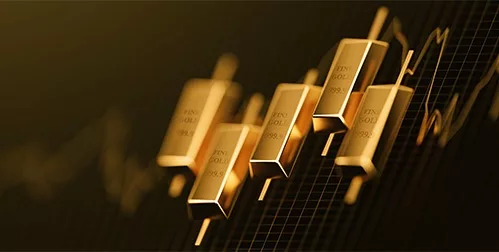Gold Climb Continues
With growing momentum, the gold market is heading to session highs. As it challenges norms, there are indications that we are entering the upswing of a multi-year gold cycle. Prices are predicted to climb, with one forecast calling for gold to hit $5,000 an ounce. Here are a few of the forces propelling the surge:
Consumer Sentiment
The University of Michigan conducts the Consumer Sentiment Index survey. The Index fell greater than economists had expected. People are growing more and more pessimistic about where the economy is headed. The gold market is seeing renewed safe-haven demand in response to the disappointing data.1
Counterintuitively, surveyed consumers expect inflation to be lower next year. Lower inflation could give the Federal Reserve room to lower interest rates. Reduced rates favor a rise in gold prices.
Stagflation Threat
Analysts elaborated on a potential source of consumer fears. Rising inflation and economic decline are making stagflation a more likely scenario. Consumers typically suffer from high prices, increasing unemployment, and harsh interest rates during stagflation. Gold, however, has historically risen in price during such periods. The chart below shows gold prices climbing during the stagflationary 1970s, surging from $100 per ounce in 1976 to around $650 in 1980, when CPI inflation topped out at 14%.
 2
2
Interest Rates & the Dollar
Momentum in the gold market is pushing prices over expected hurdles.
Gold has been gaining despite higher treasury yields. When Treasury yields (interest rates on government bonds) rise, it often puts downward pressure on gold prices. This is because higher yields can make other investments, like bonds, more attractive compared to gold, which doesn’t pay interest.
Gold also gained against a stronger US dollar. A stronger US Dollar can also be negative for gold. Gold is priced in dollars, so when the dollar strengthens, it can make gold more expensive for investors using other currencies.
China’s Economy
China’s economy is growing increasingly volatile in the face of a major real estate crisis. People there have been flocking to gold as the yuan becomes more unstable. In response, China is reversing their gold import restrictions. The People’s Bank of China is aiming to control the surge in gold prices there caused by earlier restrictions. Gold prices have been skyrocketing there since July.
China’s gold demand has been underpinning the global rise in gold’s value. China imported 900 tons of gold this year – a five year high. Gold demand is only expected to increase in China. Beyond safe haven desire, China’s upcoming traditional wedding season always increases demand.
The Gold Cycle
Analysts interpret the current data as signs that we are entering the bull aspect of a gold cycle. There have been three gold cycles in recent decades: 2001 to 2007, 2008 to 2011, and 2018 to 2020. These cycles correlate with recession and bear markets in stocks. At the outset of a cycle,
gold typically begins outperforms risk assets, like stocks, during the downturn. At the moment, gold is outperforming the stock market. It has started outperforming other commodities as well. As per earlier cycles, gold will continue rising until markets and recession worsen to a point that forces federal intervention. The Federal Reserve must then shift policy and begin cutting interest rates.
The $5,000 Prediction
Michael Lee is the founder of Michael Lee Strategy. He predicts gold will hit $5,000 an ounce within three years. He maintains that the price of gold is being held back due to the dollar and interest rates. But the decisions that have elevated those two were based on flawed data.
“Every single time a report came out [this year], it was later revised lower. That has happened every month this year. That is a 12 sigma deviation event — meaning, you’re more likely to get struck by lightning five times on the way to work than this happening,” he said. “You have to ask yourself, is this government bureaucracy, is this a flawed model, or is the Bureau of Labor Statistics cooking the books to favor the Biden administration?”3
Lee also did not rule out a late-year inflation spike due to higher oil prices, which could force the Fed to introduce another hike.
According to Lee, a recession is unavoidable. He points to the current drastic yield inversion curve. He says you typically need about 18 months before the “wheels start to come off”. That puts us towards the end of this year. He foresees tighter lending restrictions setting off a wave of defaults. The economy will then soon resemble the 2001 recession.
Lee believes that whatever forces that have been holding gold back will have to relent when the recession is in full swing. “At some point, there will be a flight to safety. If we have another breaking event, something like a Silicon Valley bank, then all of a sudden, you get above $2,000, and you really start moving,” he said.4
Conclusion
Two streams are converging at this point in time. The economy is steadily heading into a recession, with no apparent signs of turning back. Meanwhile, gold is defying conventional wisdom and continuing to surge. For those people interested in protecting the value of their retirement funds from the former, they should investigate the latter. A Gold IRA from American Hartford Gold can safeguard the value of your portfolio from an economic downturn. To learn more, contact us today at 800-462-0071.
Notes:
1. https://www.kitco.com/news/2023-09-15/Gold-prices-continue-to-hit-new-session-highs-as-UofM-consumer-sentiment-drops-to-67-7.html
2. https://www.kitco.com/commentaries/2022-08-17/The-great-stagflation-2-0-and-gold.html
3. https://www.kitco.com/news/2023-09-11/Gold-price-to-hit-5-000-in-3-years-watch-the-default-wave-kick-off-a-U-S-recession-in-Q4-Michael-Lee.html
4. https://www.kitco.com/news/2023-09-11/Gold-price-to-hit-5-000-in-3-years-watch-the-default-wave-kick-off-a-U-S-recession-in-Q4-Michael-Lee.html






